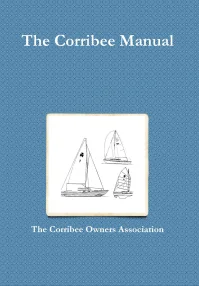Boat lift
Martin Hudson has kindly sent this description of his DIY scaffolding boat lift:
I needed to lift Sea Sprite off a rather rusty trailer so that I could begin a major refit and what I eventually came up with was the structure shown in the photographs, built from standard 48 mm scaffolding tube and fittings. It consists of twelve 8 foot poles, six 10 foot poles, one 11 foot pole, twelve 90 degree couplers, eighteen 360 degree couplers, four foot plates and four wooden boards.
The four steel foot plates were nailed to the centre of the wooden boards with deliberately long nails which would project into the grass and prevent the feet from slipping. The feet were placed to clear the full width of the trailer and to be about four inches outside of the point where the keels join the hull, fore and aft. My front garden is on a slope so each board was bedded in level.
The structure was begun with a goal post shape which straddled the rear of the boat. This was constructed on the ground with two 10 foot poles, which would become the rear uprights, joined with 90 degree couplers to an 8 foot cross beam. The structure was lifted into an upright position and walked to the two rear feet. Once the tubes were dropped over the foot pins, it became fairly manageable for one person to hold it upright while the other fitted temporary supports on both sides so that it would stand up by itself. This was an awkward part of the build because of the danger of dropping it all and damaging the boat. Another goal post shape was erected to straddle the front of the boat and held up with temporary supports. Now the front and back structures were joined on each side with upper and lower beams using 90 degree couplers.
At this point the temporary supports were removed and time was spent with a spirit level making sure that all the uprights were truly upright and the horizontals horizontal. Once the basic structure had been squared up the other triangulations were bolted in using the 360 degree couplers. The 11 foot pole is the one triangulating across the top.
The lifting was done using two duplex web slings, each 3 metre long and rated at 3 tons. These just cleared the deck on each side without wasting valuable height and provided a 90mm width to spread the load. Additional 1 ton round slings were used to join up the chain hoists at each corner and a ratchet strap was used to pull the two web slings together between the keels to stop them slipping.
Four chain hoists might seem excessive but they do simplify things. They allow minimal height, no spreader beam, no hull pinching, no swinging around and complete control of pitch and yaw. The chains allow operation from ground level which speeds up the synchronized shuffling between front and rear pairs.
Planning and obtaining parts took a couple of weeks but the structure was erected in about 2 hours and the lift completed in about 15 minutes. It went very well and felt completely under control. Before I lowered it to the ground I was able to examine the bottom of the keels with a mirror, something you don’t often get to do.
I would think that to lift a fin keeled boat, the longer tubes involved would require more triangulation for strength and that outriggers would be required for stability.
The initial outlay for this project was probably similar to a one off lift at a marina as most of the parts were obtained second hand. However the capability is there for good, the parts can be used for other things, and when not in use the parts can be stored flat and out of the way.
Incidentally the structure was removed after the lift to spare the neighbours, but I have recently started to think about a winter cover. I wonder…
Contribute
Do you have a story, information, brochure, manual, link or other relevant content that should be on this page? If so, we would be very grateful if you would leave it as a comment or email corribeeeditors@googlemail.com so we can post here – thanks!



June 2, 2020 at 09:33 |
Thank you for Sharing 🙂 gohoist is expensive (£2.5K delivered to the UK) but another option for a club type environment.
August 29, 2019 at 20:35 |
here is a video of the process usually performed:
One can buildt trestles out of 4×4 if one cant get any.